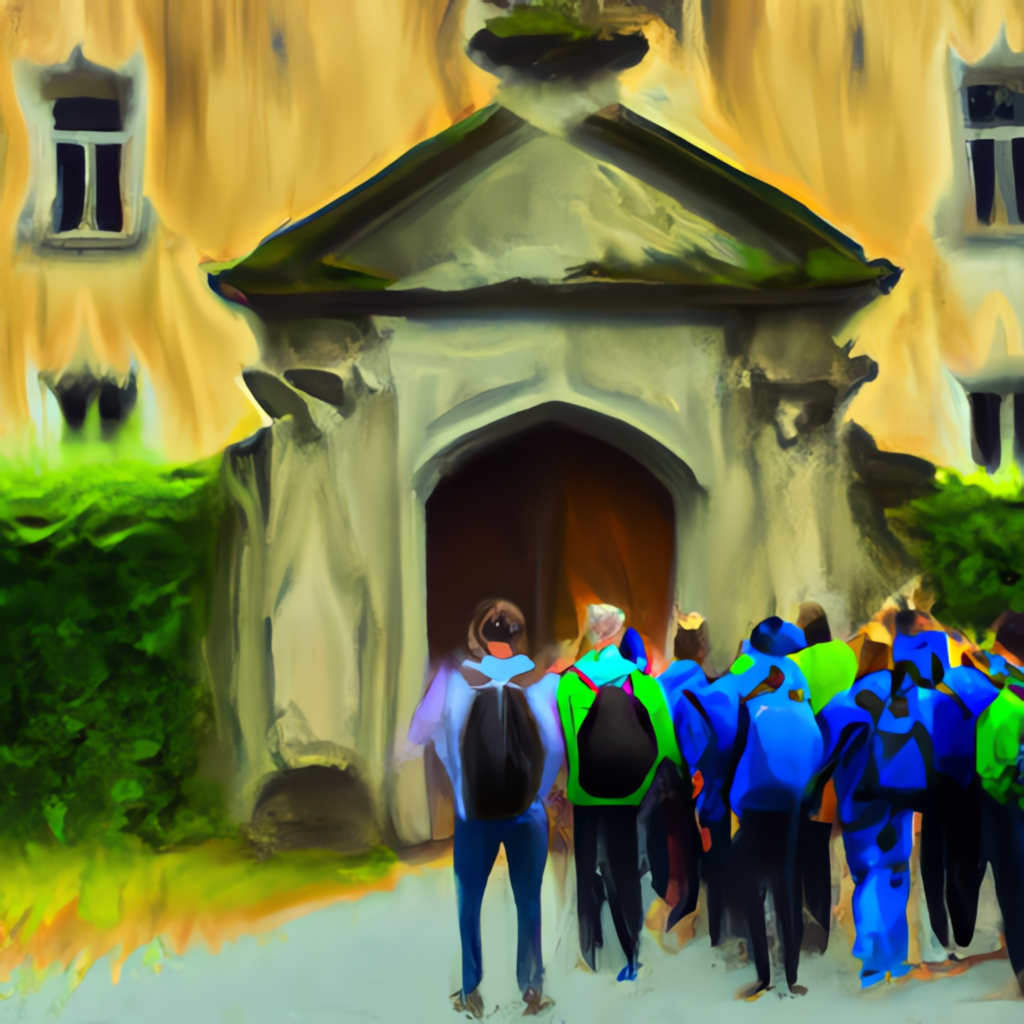In recent years, dark tourism has emerged as a popular travel trend, attracting millions of curious and adventurous travelers around the world. From abandoned cities and haunted mansions to war memorials and sites of tragic accidents, dark tourism involves visiting places with a macabre history or eerie ambiance that is often associated with death and suffering. Despite the somber nature of this form of travel, it’s gaining traction as a unique way to learn about history, culture, and human nature.

While many people may not initially feel drawn to the idea of dark tourism, it offers a unique perspective on history, culture, and society that may not be found in traditional travel experiences. For some, it provides a way to confront fears and limitations, while for others, it’s an opportunity to pay homage to victims and survivors of challenging times. Additionally, dark tourism can also be a way to spark conversations and debates about morality, justice, and the darker aspects of our human experience.
1. Defining Dark Tourism
The concept of dark tourism has been gaining increasing attention over the years, as more people have come to appreciate the value of exploring the darker and more somber facets of history. Simply put, dark tourism refers to visits to places associated with death, suffering, tragedy, and horror. The sites that fall under the umbrella of dark tourism can range from the Holocaust Museum in Israel to the streets of New Orleans, where ghost tours are a popular attraction. In essence, understanding dark tourism involves examining the ways in which visitors engage with memory, trauma, and loss, as well as the dynamics of power and representation that shape the stories we tell about these places. While dark tourism can be a challenging and uncomfortable experience for some, it can also be a way to learn about the human experience in a profound and meaningful way.
2. Exploring the Types of Dark Tourism

Welcome to “Embrace the Dark Side: Discovering the Fascinating World of Dark Tourism!” In this writing, we will explore the world of dark tourism, a growing phenomenon that involves travelling to places associated with death, tragedy, and suffering. We will look at the different types of dark tourism and what makes them unique. Dark tourism can be divided into several categories, including war tourism, disaster tourism, memorial tourism, prison tourism, and nuclear tourism. Each type of dark tourism offers visitors a different perspective on history and human behavior. Some may find it morbid, while others view it as an opportunity to learn, reflect, and honor those who suffered or perished. Regardless of your stance, understanding the different types of dark tourism can enrich your travel experiences and broaden your horizons. Let’s dive into each type and see what makes them so fascinating.
3. Examining the Appeal of Dark Tourism
Embrace the Dark Side: Discovering the Fascinating World of Dark Tourism is an exploration into the emerging phenomenon of dark tourism. It involves the exploration and discussion of historical, cultural, and natural sites that are associated with tragedy, suffering, or death. The practice has been on the rise in recent years, and this paper examines the appeal behind it. Reasons range from an interest in history to a desire for novelty or an attempt to confront mortality. These sites are frequently popular tourist destinations, and in some cases, have become important sources of revenue for local economies. However, it is important to examine the ethical implications of this trend as well, including issues like appropriation, exploitation, and respectful representation. Overall, while dark tourism may not be for everyone, it is certainly a fascinating and complex field worth exploring.
4. Understanding the Ethical Considerations of Dark Tourism
Dark Tourism is a rapidly growing industry, but it’s essential to understand the ethical considerations that come with it. Dark Tourism involves visiting places associated with death, tragedy, or suffering, such as sites of historical atrocities, museums about genocide, and disaster zones, to name a few. When planning your next adventure, it’s important to consider how your visits may impact the local community, survivors, or the deceased, and their loved ones. It’s crucial to be mindful of your behavior, language, and actions as they may be perceived as insensitive. Additionally, one should be aware of the potential danger and safety risks associated with visiting these sites. Embracing the Dark Side can be fascinating, but respecting and understanding the ethical implications is critical for a responsible and meaningful experience.
5. Assessing Popular Dark Tourist Destinations
Dark tourism, or thanatourism, is a growing trend in the tourism industry. More and more people are becoming interested in visiting sites that hold a dark and often gruesome historical significance. From the Berlin Wall to the former concentration camps across Europe, dark tourist destinations see millions of visitors every year. Despite the fact that these tourists visit such sites out of a fascination with death, their intentions should not be assumed to be macabre or improper. In fact, dark tourism offers an opportunity to educate and learn from the past, aid in the preservation of such sites, and inform the public on the importance of remembering history.
However, not all destinations are created equal. It is important to thoroughly assess popular dark tourist locations to determine if they are ethical and appropriate to visit. For example, some destinations may exploit the sites for financial gain without properly respecting the significance of the history behind them. Others may lack transparency about the accuracy of the historical information provided to visitors. Any destination that fails to respect the dignity of the dead or the significance of historical events must be approached with caution. Thus, it is important for travelers to research heavily before deciding to visit any dark tourism site and to ensure that they approach these destinations with the utmost respect.
6. Exploring the Psychological Benefits of Dark Tourism
Embrace the Dark Side: Discovering the Fascinating World of Dark Tourism is a comprehensive exploration of the psychological benefits associated with dark tourism and its growing popularity as a subcategory of travel. The term “dark tourism” refers to the phenomenon of traveling to destinations that are historically tied to tragic events, such as genocide sites, concentration camps, disaster zones, and even haunted places. While the idea of seeking pleasure in macabre settings may seem strange to some, dark tourism provides a unique opportunity to connect with history, challenge one’s perspective, and reflect on the human condition. In addition, research suggests that dark tourism can have significant psychological benefits, such as fostering empathy, promoting personal growth, and facilitating healing and closure for those affected by tragedy. This document will delve into the different aspects of dark tourism and explore why more and more people are embracing the darker side of travel.
7. Maximizing Your Dark Tourism Experience
Dark tourism is a unique phenomenon that is gaining popularity worldwide. It involves visiting places that are associated with tragedy, death, or suffering. Whether you’re interested in history, current events, or simply the macabre, dark tourism can provide a fascinating window into the past and present. To truly maximize your dark tourism experience, it’s important to plan ahead and approach each site with respect and sensitivity. From researching your destination to engaging with local communities, these tips will help you navigate the complex and often emotional world of dark tourism.
8. Finding Supportive Dark Tourism Communities
When it comes to pursuing an interest in dark tourism, finding and connecting with supportive communities can be a key component of a fulfilling experience. Not only do these groups provide a forum for discussion and the exchange of ideas, but they also offer a sense of belonging to individuals who might otherwise feel isolated in their interests. There are many ways to find these supportive communities, from social media groups to specialized forums and websites dedicated to topics such as true crime, haunted places, and historical tragedies. Additionally, many dark tourism attractions themselves offer guided tours and themed events that encourage community participation and interaction. Taking the time to explore these opportunities and connect with like-minded individuals can not only deepen one’s understanding and appreciation for dark tourism, but also provide a valuable sense of solidarity and camaraderie within this often misunderstood and stigmatized interest.
In conclusion, dark tourism is an intriguing and thought-provoking way to explore history, culture, and humanity’s darker side. From sites of tragedy and death to infamous prisons and abandoned places, these destinations provide visitors with a unique perspective on past events and a chance to reflect on the consequences of human actions. While some may criticize dark tourism for being exploitative or inappropriate, it offers a valuable opportunity to learn from the past and remember the people and events that shaped our world today.


